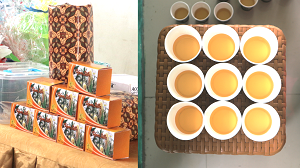Pemanfaatan Rambut Jagung (Zea mays L.) Menjadi Teh Herbal “KoNsilk” kepada Kader Puskesmas Perumnas 2 Kota Pontianak Utilization of Corn Silk (Zea mays L.) Into "KoNsilk" Herbal Tea for Cadres of Public Health Center 2 Pontianak City
Main Article Content
Abstract
The impact of the Covid-19 pandemic is felt by the people of Pontianak, in the economic, sociocultural, and health fields. One of the prime commodities in Pontianak is corn farming. The aim of the PKM Program is to innovate corn-based processed products. This PKM activity began with outreach to the heads and employees of the Puskesmas, as well as identifying health cadres as potential participants in training related to using corn silk as herbal tea drinks. Training on using corn silk as herbal tea drinks for cadres was carried out offline and interactively using leaflets, videos, and hands-on practice. Evaluation and monitoring activities are carried out using a Google form (pre-test and post-test). The results of the PKM activity showed success in understanding the cadres with good knowledge when the pre-test was carried out by only ten people (30.30%). After being given knowledge training, respondents in the good category amounted to 30 people (90.90%). PKM activities targeting UPT Puskesmas Perum II cadres increased the ability of cadres to utilize corn silk waste in herbal tea. The next activity is expected to be able to assist so that the resulting product obtains a permit.
Downloads
Article Details

This work is licensed under a Creative Commons Attribution-ShareAlike 4.0 International License.
Authors who publish with this journal agree to the following terms:
- Any article on the copyright is retained by the author(s).
- Author grant the journal, right of first publication with the work simultaneously licensed under a Creative Commons Attribution License that allows others to share work with acknowledgment of the work authors and initial publications in this journal.
- Authors are able to enter into a separate, additional contractual arrangements for non-exclusive distribution of published articles of work (eg, post-institutional repository) or publish it in a book, with acknowledgment of its initial publication in this journal.
- Authors are permitted and encouraged to post their work online (e.g., in institutional repositories or on their websites) prior to and during the submission process, as can lead to productive exchanges, as well as earlier and greater citation of published work.
- The article and any associated published material is distributed under the Creative Commons Attribution-ShareAlike 4.0 International License
References
Chen, H., Jia, Y., & Guo, Q. (2020). Chapter 6 - Polysaccharides and Polysaccharide Complexes as Potential Sources of Antidiabetic Compounds: A Review. In: Atta-ur-Rahman (Ed) Studies in Natural Products Chemistry. Elsevier, Amsterdam. 67, 199–220. https://doi.org/10.1016/B978-0-12-819483-6.00006-0
Hasanudin, K., Hashim, P., & Mustafa, S. (2012). Corn Silk (Stigma Maydis) in Healthcare: A Phytochemical and Pharmacological Review. Molecules, 17(8), 9697–9715. https://doi.org/10.3390/molecules17089697
Laeliocattleya, R. A., Martati, E., Alwi, A. N. S., Aulia, L. P., & Yunianta. (2020). The Characteristics of Corn Silk (Zea Mays L.) Herbal Drinks Tea with Vacuum Drying Method as Antioxidant. IOP Conference Series: Earth and Environmental Science, 475(1), 012023. http://doi.org/10.1088/1755-1315/475/1/012023
Li, Y., Hu, Z., Wang, X., Wu, M., Zhou, H., & Zhang, Y. (2020). Characterization of a Polysaccharide with Antioxidant and Anti-Cervical Cancer Potentials from the Corn Silk Cultivated in Jilin Province. International Journal of Biological Macromolecules, 155, 1105–1113. https://doi.org/10.1016/j.ijbiomac.2019.11.077
Morshed, S. & Islam, S. M. S. (2015). Antimicrobial Activity and Phytochemical Properties of Corn (Zea Mays L.) Silk. SKUAST Journal of Research, 17(1), 8–14.
Nessa, F., Ismail, Z., & Mohamed, N. (2012). Antimicrobial Activities of Extracts and Flavonoid Glycosides of Corn Silk (Zea Mays L). International Journal of Biotechnology for Wellness Industries, 1(2), 115–121. http://dx.doi.org/10.6000/1927-3037/2012.01.02.02
Ren, S. C., Qiao, Q. Q., & Ding, X. L. (2013). Antioxidative Activity of Five Flavones Glycosides from Corn Silk (Stigma Maydis). Czech Journal of Food Sciences, 31(2), 148–155. http://doi.org/10.17221/194/2012-CJFS
Senphan, T., Yakong, N., Aurtae, K., Songchanthuek, S., Choommongkol, V., Fuangpaiboon, N., et al. (2019). Comparative Studies on Chemical Composition and Antioxidant Activity of Corn Silk from Two Varieties of Sweet Corn and Purple Waxy Corn as Influenced by Drying Methods. Food and Applied Bioscience Journal, 7(3), 64–80.
Shalihah, I. M., Pamela, V. Y., & Kusumasari, S. (2020). Corn Silk Tea Extract as Antidiabetic : A Review. Food ScienTech Journal, 2(2), 75-79. http://dx.doi.org/10.33512/fsj.v2i2.9647
Singh, J., Inbaraj, B. S., Kaur, S., Rasane, P., Nanda, V. (2022). Phytochemical Analysis and Characterization of Corn Silk (Zea Mays, G5417). Agronomy, 12(4), 777. https://doi.org/10.3390/agronomy12040777
Suwaryo, P. A. W. & Yuwono, P. (2017). Faktor-Faktor Yang Mempengaruhi Tingkat Pengetahuan Masyarakat dalam Mitigasi Bencana Alam Tanah Longsor. Prosiding University Research Colloquium, 6, 305-314.
Syawal, A. & Laeliocattleya, R. (2020). Potensi Teh Herbal Rambut Jagung (Zea mays L.) sebagai Sumber Antioksidan: Kajian Pustaka. Jurnal Ilmu Pangan dan Hasil Pertanian, 4(1), 1–6. https://doi.org/10.26877/jiphp.v4i1.4056
Wijianto, B., Fahrurroji, A., Kurniawan, H., & Nugraha, F. (2021). Pemanfaatan Whatsapp Sebagai Media Edukasi Peningkatan Pengetahuan Kader Dalam Upaya Pencegahan Penyebaran Virus Covid-19. Al-Khidmah, 4(1), 25–30. http://dx.doi.org/10.29406/al-khidmah.v4i1.3041
Wijianto, B., Setyaningrum, A., Adinda, L. P., Thendralie, A., & Putri, L. H. (2022). Penerapan Perilaku Sehat Dalam Upaya Peningkatan Kualitas Hidup Masyarakat di Desa Bintang Mas Kubu Raya. Al-Khidmah, 5(1), 19-24. http://dx.doi.org/10.29406/al-khidmah.v5i1.3693
Zhao, W., Yin, Y., Yu, Z., Liu, J., & Chen, F. (2012). Comparison of Anti-Diabetic Effects of Polysaccharides from Corn Silk on Normal and Hyperglycemia Rats. International Journal of Biological Macromolecules, 50(4), 1133–1137. https://doi.org/10.1016/j.ijbiomac.2012.02.004
